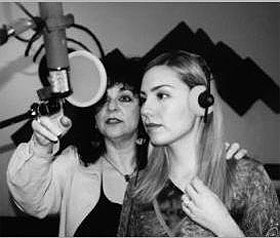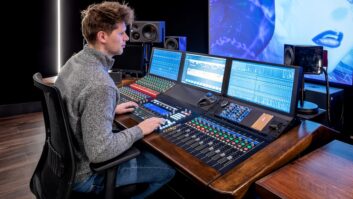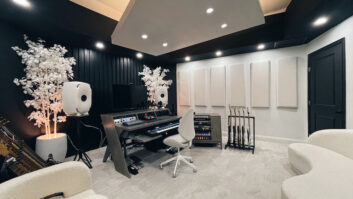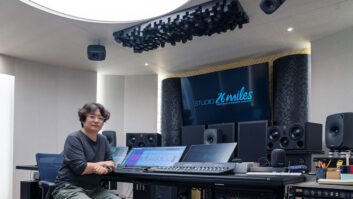
If you’ve been a producer or engineer for long enough, you’ve doubtlessly experienced your share of hellacious recording session: the ones in which the vocalist just can’t seem to get comfortable or perform to his/her capacity. Dimming the lights and lighting some candles to create a more relaxed mood just isn’t helping. Is he/she just having an “off” day or are there some adjustments that you can make to salvage the session? This month’s column features advice from two professionals whose techniques have effectively solved problems that otherwise would have derailed a session and left everyone involved unsatisfied.
GOING HEAD TO HEAD: THE PERFORMER VS. THE ROOM
It happens all the time. A singer comes into a recording session seemingly ready to go, but things head south fast. He/she can’t hit the pitch. Can’t hear himself, even though you’ve got his/her vocals turned up in the headphones. Can’t deliver without straining. What’s wrong? It’s got to be something he/she is or isn’t doing that’s screwing everything up, right? Not necessarily. While there are definitely times in which singers step into a recording session either unprepared or simply lacking the goods to deliver a solid performance, there are also times when the reason a recording session isn’t successful doesn’t fall on the singer’s shoulders (or vocal cords) at all.
In fact, you might be surprised to learn that there are a number of factors associated with the vocal booth that can make or break a recording session, beyond just microphone.
Headphones: You are what you hear. This is one adage that rings true for singers. And what they are able to hear depends greatly on both the type of headset available to them and the mix in that headset. Yes. You read that right: the type of headphones can make a difference.
Jeannie Deva working in the vocal booth with an artist
“All engineers and producers are familiar with the change in the audio spectrum and change in tonality when listening back and monitoring through various speaker types, which is why they tend to listen to a mix on small Audix speakers, as well Genelec near-field monitors,” explains Jeannie Deva, a celebrity voice and performance and vocal session coach who has worked with multiple artists, including Grammy Award–winners Aimee Mann and Patty Griffin, Number One Billboard Dance Chart artist Samantha James and leads in a number of Broadway shows, such as Wicked, Rent and Grease. “The mix in a headset is no different. Some models boost the treble, some boost the mids and some are more transparent so the sound spectrum can be represented by the make and model of the headset, and this can impact the singer’s experience significantly.”
It’s also important to remember, says Grammy Award–winning engineer Vance Powell, that even if you feel you’ve created a headphone mix that the singer “should be able to sing well with,” it doesn’t mean that the singer can. “Sometimes an artist’s vocals simply don’t sound or feel right to them,” says Nashville-based Powell, who has worked with such bands and artists as Jars of Clay, Jack White and Red Fang, to name just a few. “Maybe there’s too much reverb or they want a greater degree of compression in their headphones than I’d like to include in the mix. But I know that giving the singer what he needs to perform well is crucial, so oftentimes I’ll just use a plug-in or patch the compressor so that what he’s hearing when he sings more-closely resembles the finished product that he’s hearing in his head, and it feels like the record to him. It’s usually a really good and easy way to get past hang-ups and get the most out of the singer and the session.”
You feel what you wear. In addition to the tonal qualities represented with a headset, there’s a comfort level and because all preferences are different, it is a good idea to have more than one headset available. Some headsets are heavy, uncomfortable and are simply not conducive to being creative and free. “If a headset is weighing on a singer’s head like a vice and they have to take one ear off just to get comfortable, they are competing with creating the correct mood and passion of a song,” says Powell. Unfortunately, if the type of headset a singer is using isn’t matching up with what he/she is producing, what will often happen is the singer will start muscularly fighting what he or she is getting back in the headset, and that never leads to anything good.
Vance Powell
You’re as good as your EQ. Another factor that will promote or restrict a vocalist’s ease of singing is the EQ placed on the vocals. “It all comes down to the kind of bump that the EQ is producing,” says Deva, who says EQ problems are frequency the issue. “Is it flat? Is it bumping at 10k? These are important questions for an engineer to ask because if the frequency isn’t matching the personality of the singer’s voice, the singer will be fighting against it. When a singer starts pushing or straining, the engineer shouldn’t automatically assume it’s lack of vocal technique. Sometimes the singer’s technique does need help, but it’s important to make sure that the electronics are in line with the singer.”
Deva cites an example in which she was working with a very accomplished producer whose vocalist kept singing the chorus out of tune. “He was straining and sounded just miserable, and the producer kept saying, ‘Sing it again, you’re off.’” After about five or six takes and his persistent pushing for the singer to try to stay on pitch, Deva suggested that he boost the treble EQ and then have him sing it again. “As soon as he did, the singer sang it and nailed it. The reason the simple adjustment made the difference was because there wasn’t enough of the treble spectrum in what the singer was hearing back, so it made him feel like he was hitting a ceiling that he was pushing against. By boosting the EQ, it literally raised the roof and gave the singer more space to sing in.” In fact, adjusting the EQ can help a singer relax and find the pitch more easily, in general.
You thrive in the sweet spot. Believe it or not, another primary issue that conflicts with a successful session hinges on the simple positioning of the singer in the room. “Even if a room is built to be acoustically perfect, it will still have a ‘sweet spot,’ a place where everything comes together just right to make the singer sound his or her best,” explains Deva. “On the flipside, that same room will also have places that cause the voice to constrict.” According to Deva, to get the most out of the session and the singer, the angle of the singer’s position must line up with the sweet spot.
This is a phenomenon she has experienced firsthand on more than one occasion. An example: Deva was hired to serve as a session vocal coach for two singers who were working on a major-label project at a studio in Hamburg, Germany. Her job was to make sure that the singers were ready to sing all of their songs, so she was present during the sessions. Unfortunately, when the first singer went into the booth and began to sing, he immediately started having difficulty, so Deva was asked to go in and sing a full-out vocal so that he could follow it. “As soon as I started to sing, my voice jammed up. I adjusted the headset and went for another take, and it jammed up again. There was no compression on my voice, but if felt like there was, and I couldn’t seem to get beyond it.”
She knew there was something strange going on with her position in the room so she stood in the middle of the room, began singing “ah” and slowly began turning 360 degrees. In certain directions her voice got squeezed, but, finally, she found the place where her voice opened and relaxed: the sweet spot of the room.
“It’s important for engineers to understand the technology well, but they also must understand that the audio world is based on mathematics and physics,” adds Powell.
GETTING TO KNOW THE ARTIST
Sweet spots and headphones aside, the most successful sessions are the ones in which the producer/engineer has taken the time to get to know and communicate with the singer. If Powell is working with a band for the first time on a multi-day project, for instance, he will always meet with them before recording. “I like to bring the band over, have them check out the space and get a feel for things, play some music and let them chill for a while, and give them a chance to get comfortable,” says Powell. “After that, we’ll talk about how many songs they want to do and what they want to accomplish.” Powell contends that one of the culprits that lead to unsuccessful sessions is unrealistic expectations. “I’ve had artists say they want to record 27 songs in a two-day session and make it sound like Pet Sounds meets Abbey Road,” he explains. “Those kinds of expectations are going to lead to a huge disappointment because it just isn’t realistic.”
Realistic expectations aren’t limited to the singer. Producers also must have them, but for that to happen, they have to take the time to get to know the singer. “I think it’s essential that a producer or engineer learn how the singer works and sounds when she’s not in the studio,” says Deva. “A lot of times, if the singer is experiencing issues, the person sitting in the control room doesn’t understand why because he hasn’t taken the time to listen to what the singer sounds like off-mic and without all of the other stuff going on around them in the vocal booth.”
Most importantly, as an engineer you need to know what you’re doing. “Just because you have a Pro Tools box doesn’t mean you know how to use it,” cautions Powell. “The more you read and study the craft, and the more you learn about the business of making records, the better you’re going to be able to handle unexpected curves that vocal sessions tend to throw at you during sessions.” Powell says the best engineers are the ones that are able to think on their feet, maintain a sense of calm in pressure situations and never hint that there is an issue they don’t know how to resolve, even if it takes them a few minutes to figure out. “As an engineer, you always have to be in control. The minute you show any weakness or make it seem like you don’t know what you’re doing is the minute your client loses confidence in you and the session has no where to go but down. You’ve got to keep your cool.”
THE SINGER’S RESPONSIBILITY
Don’t worry. If you’re an engineer or producer, it’s not all on you. This article is not at all suggesting that successful recording sessions are solely your responsibility. Singers still have to do their part to ensure that things go smoothly. Here are a few pointers singers should take into consideration.
1. Knowledge is power. Even though, as a singer, you’re not expected to understand all of the technical aspects of recording sessions, the more educated you become, the more it helps you to maintain your own sense of personal strength and ability. “A singer who knows nothing about how things work in the recording studio—no matter how many times he has recorded—will have more difficulty repeating good sessions because he won’t know what made it successful,” says Deva, who is the author of numerous books and CDs designed to help singers, as well as the originator of The Deva Method®. “There are so many times that I’ve been in a session with a singer who is having difficulty, and he has no idea what to say or how to fix things, and he is just waiting for someone to rescue him, but no one can because they don’t really understand what he’s going through.” That said, as a singer, you must do your homework to prepare for vocal sessions and be sure to take notes about your experiences in the booth that can be applied the next time you have a session.
2. Speak up. Speak specifically. “If you’re in the vocal booth and you need more or less of something in your headphone mix, you should make sure to explain exactly what you’re looking for,” says Deva. “Do you need more of your vocals? Less guitars? Less percussion? Being specific helps the engineer know what your specific needs are so the engineer can address the problem more effectively and more quickly.” And, Deva says, if all else fails, you should take one ear off of your headset. The bottom line is, if you’re a singer and you’re not getting what you need, it’s up to you to let the producer or engineer know.
3. Change things up. If it feels difficult at all to sing in front of the mic and the problem isn’t getting resolved quickly, Deva suggests asking the producer or engineer to sing the same section of the song a cappella or off-mic. “Maybe you can sing with music coming out of monitors so the producer can hear you singing the section uninfluenced,” says Deva. “If you do it that way, you’re asking your tech team to problem-solve.”
4. Be prepared. While this should be a no-brainer, some singers fail to prepare before a recording session, believing that the more spontaneous they are, the more natural the session will be. That’s rarely the case. “Singers should always arrive with their lyrics memorized so they’re not trying to read as they sing because it diminishes the power of the performance,” says Deva. “As a singer, you should know the song so well that it has become part of your story. This will only help you to express it more authentically and grab the listener with your delivery.” Singers should also request a rough mix or basic rhythm track to practice with several days before coming into the studio. And while this certainly won’t be popular with some, to get the most out of a session, singers should refrain from drinking alcohol before a session because it will wind up causing them to push their voices because of dehydration.







